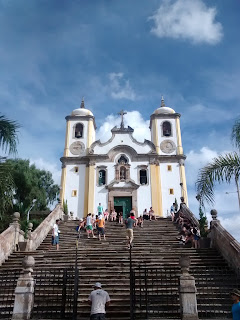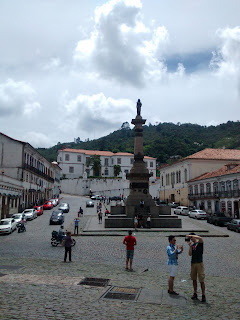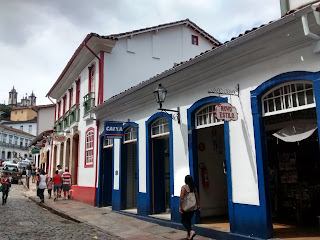OURO PRETO
History
No place can be a better symbol of the Brazillian colonial past than Ouro Preto, which means "Black Gold". When gold was found in this part of Brazil, by the end of the XVII century and beggining of the XVIII, a gold rush started to the province of Minas Gerais (General Mines), attracting ambitious people to a colony where once the main economic activity was the sugar cane plantation and the extrativism.
The city flourished as one of the most important within the portuguese colonies, moving the economic centre of Brazil to the southwest region, and making the port of Rio de Janeiro the most important at the time, as it provided the best route to the shores. Later, the capital of the colony would be transferred from Salvador of Bahia to Rio, as the gold was transported from Minas to Rio.
Barroque Art in Ouro Preto
The gold rush provided enough resources for one the most impressive collections of Barroque Art in Brazil, since many churches where built in this style, with heavy wood doors and furniture and adorning altars covered with gold. The most famous sculptor, known as Aleijadinho, made hundreds of religious sculptures in a very peculiar and personal interpretation of the barroque.
Aleijadinho was the nickname of Antônio Francisco Lisboa, a nickname that in portuguese means something like small handicapped; in fact, his physical difficulties made his art even more impressive.
This lead Ouro Preto to be the first Brazillian site to be considered a World Heritage Site by UNESCO.
Aleijadinho´s sculptures can be found on nearby cities, speacially in Congonhas, where it is located his masterpiece, the sculptures of the profhets. There, in the churchyard of the Sanctuary of Bom Jesus de Matosinhos, Aleijadinho used soapstone to carve famous images of the twelve prophets. They have human dimensions and are visited annually by thousands of tourists.
Inconfidência Mineira - The Minas disloyalty
The amount of gold taken from the region and the tributes imposed by the Portuguese Crown made a more illustrated local elite start to question the Portuguese rule over Brazil. A movement lead by Joaquim José da Silva Xavier, called Tiradentes (the "teethtaker"), a local dentist, was the first attempt to declare the Brazil´s independence. The plot was named Inconfidência Mineira (the Minas disloyalty) as some people wanted to organise a revollution against Portugal. The plot was discovered and the punishment applied by the Crown was an example to all traitors, and Tiradentes was quartered in the public square.
The main building in Ouro Preto´s Central Square now hosts the Museum of Inconfidência. Besides the history of Inconfidência, it shows in a very interisting way how people lived there at that time, for example, which clothes they used, social positions, food and transportation. The museum also hosts many barroque sculptures and utensils from that time.
Getting there
Ouro Preto is about two-hours drive from Belo Horizonte, the capital of the State of Minas Gerais. If you rent a car at the international airport in Confins (CNF), you´ll have to cross an outer highway around Belo Horizonte (also known in Brazil as BH). After that, a small road among the mountains leads you to Ouro Preto. Depending on traffic jams at Belo Horizonte , the trip can take more time.
Of course, tour operators offer the same ride. Knowing nearby cities is also a good trip, as they form an ensemble of historic cities from the times of the gold and diamond rush, during colonial period of Brazillian history.
Thursday, August 13, 2015
Sunday, August 9, 2015
LENÇÓIS MARANHENSES
The Place
In the north of Brazil, beetween the Amazonian states and the northeast states, lays the state of Maranhão. It separates the biggest rainforest in the world, the Amazônia, from the semi-arid areas in the countryside of the northeast states, the caatinga. And, in the shores of Maranhão, there´s a very unique formation of dunes and lagoons, known by the name of Lençóis Maranhenses.
This set of white and smooth dunes, seen from afar, seens sheets ("lençóis", in portuguese) lying over a bed.
In this case, a very big bed, which takes many square kilometers from the ocean to the borders of the Preguiças river, which is inside the Lençóis Marenhenses National Park.
Photos can´t make justice for the beauty of the place, and by only beeing there one can realize the high the dunes can get. Better prepare your legs, it won´t be an easy ride.
During and some time after the rainy season, lagoons are formed inside the dunes, producing a very different set of natural swimming pools.
Subscribe to:
Comments (Atom)
SP GLBT Pride - the best places to dance
São Paulo´s LGBT Pride - the best parties and discos to dance Avenida Paulista, where every year, at june, the São Paulo gay pride i...

-
Chapada dos Veadeiros (7) The Moonvalley Rocks at the moonvalley, at Chapada dos Veadeiros in Brazil (O vale da Lua) In a p...
-
Chapada dos Veadeiros (5) - The Canions´ Track (The Rio Preto and its canions, forming natural swimming pools, inside Chapada dos Vea...
-
Cachoeira do Tremembé Tremembé Waterfall The Cachoeira do Tremembé , in the Maraú Peninsula area, at Bahia, northeast of Brazil ...









































